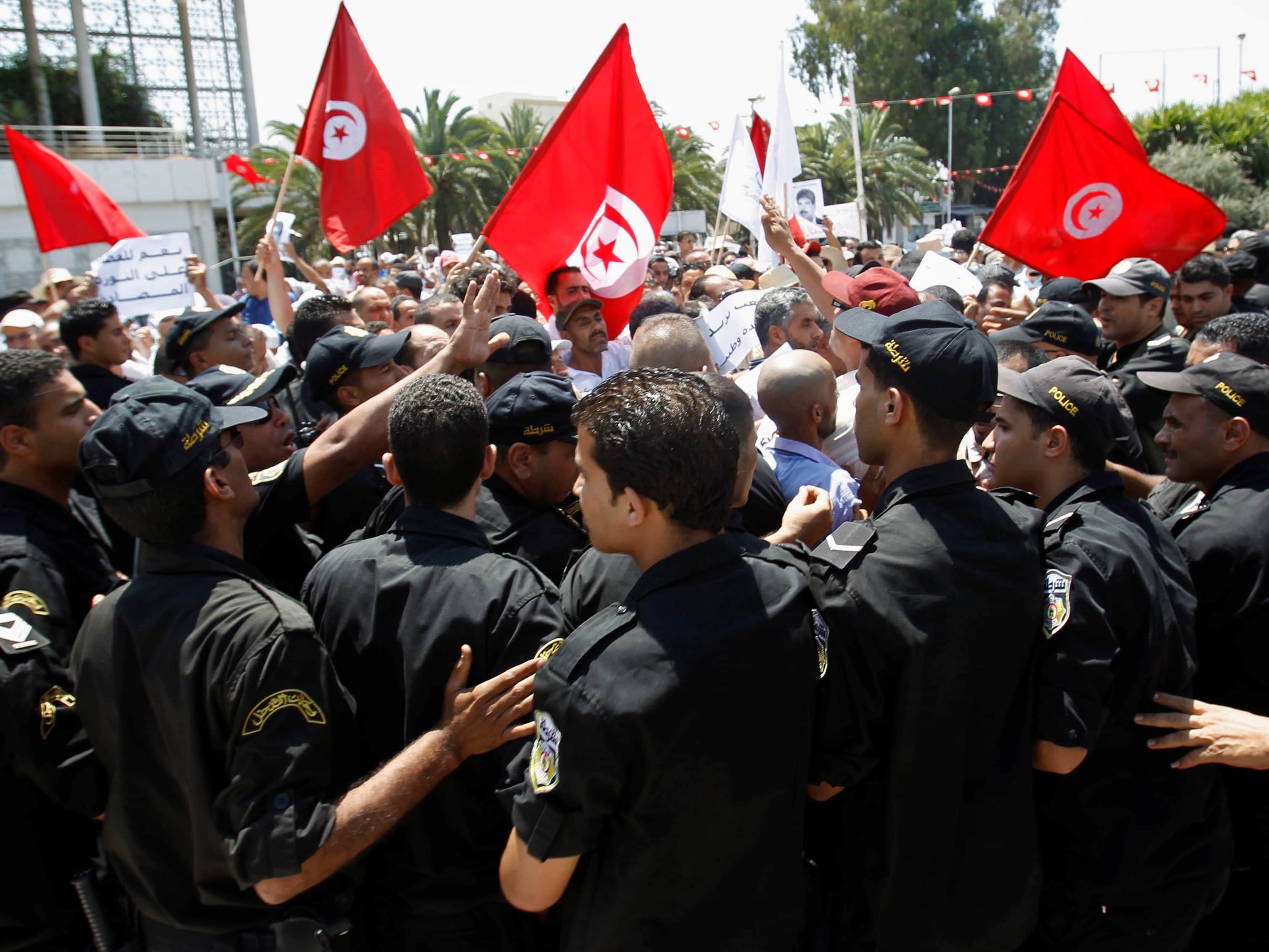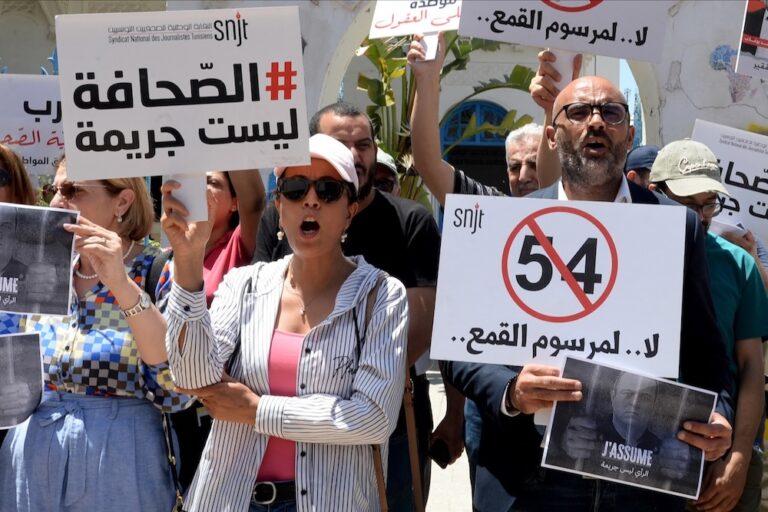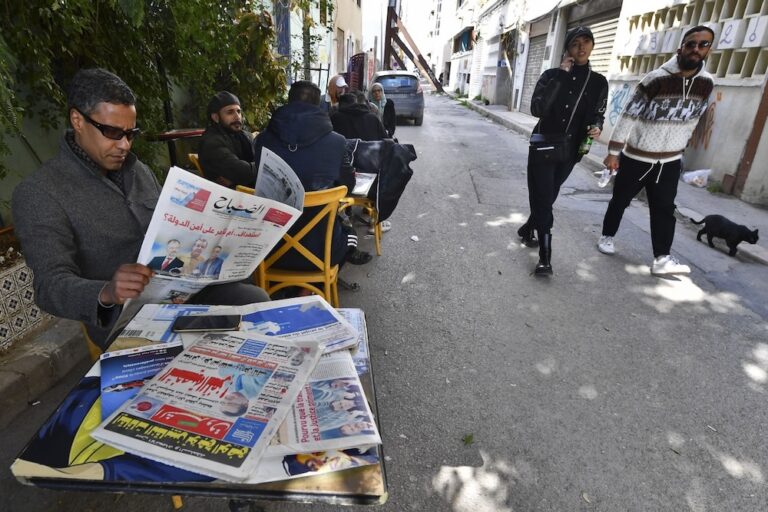The recent police violence against peaceful protesters in Tunis underscores the need for Tunisia's government to issue clear orders to protect and allow peaceful protests, as well as new guidelines on when and how teargas may be used.
The police violence against peaceful protesters in Tunis on July 27, 2013, underscores the need for Tunisia’s government to issue clear orders to protect and allow peaceful protests, as well as new guidelines on when and how teargas may be used.
Many witnesses Human Rights Watch interviewed described excessive use of teargas by the police, which would be unlawful, to break up a peaceful sit-in in front of the National Constituent Assembly (NCA). The demonstrators were protesting the assassination of Mohamed Brahmi, an opposition member of the assembly. Several witnesses said the police insulted and beat protesters and journalists in an effort to disperse them.
“Police brutality heightens tensions following Mohamed Brahmi’s killing and can only fuel discontent and violence,” said Nadim Houry, deputy Middle East and North Africa director at Human Rights Watch. “The killing of a high-profile political figure on the street in broad daylight is all the more reason why Tunisians need to know that the government intends to protect their rights.”
Interior Minister Lotfi Ben Jeddou should issue clear orders to all police forces to respect freedom of assembly and to use force only when strictly necessary, Human Rights Watch said. The authorities should immediately investigate and prosecute officers and police agents who use unlawful force against protesters.
The July 25 assassination of Brahmi, a member of the assembly and until recently secretary general of the leftist nationalist party The Popular Current, sparked protests around the country as well as a deep political crisis. On July 26, 42 opposition members of the assembly announced that they had suspended their participation and demanded its dissolution, the replacement of the current government with a new one consisting of technocrats, and the establishment of a commission of experts to finish drafting the constitution.
The 42 members announced that they would start an open sit-in in front of the assembly building, and called for supporters to take to the streets all around the country to put pressure on the government.
On July 27, following Brahmi’s funeral, hundreds of protesters began to gather in a square in front of the assembly building. Pro-government protesters gathered on the other side of the square, with police between them.
Ten witnesses Human Rights Watch interviewed said the gathering was peaceful. The witnesses gave consistent accounts that half an hour after the crowds gathered, and without warning, police used teargas against both groups to disperse the peaceful crowds.
As a riot control method, teargas should be used only when necessary as a proportionate response to quell violence. International guidelines such as the UN Principles on the Use of Force and Firearms stipulate that the police are expected to use discretion in crowd control tactics to ensure a proportionate response to any threat of violence, and to avoid exacerbating the situation.
Aymen Rezgui, responsible for press freedom at the Union of Tunisian Journalists, told Human Rights Watch:
I was one of the first people to arrive at the site of the NCA, around noon. There were about a dozen people there already. Pro-government protesters also started to gather on one side of the square. They were chanting “People are Muslims and will not surrender Islam” and other pro-government slogans. They were around 30. Police forces came closer to the two groups and interposed between them. After some minutes, and without prior warning, they started firing teargas in the air.
Rezgui said that between 1 and 4 p.m., the police used teargas three times. He said that in one instance, the police deliberately gathered the antigovernment crowd in the middle of the square and then started firing teargas in their direction:
The crowd was dispersed in and around the square. Police agents started asking people to gather in the middle. When they were almost all there, some antiriot policemen started firing teargas directly in the middle of the crowd. I was standing close to Olfa Ben Chaabane, a journalist from BBC Arabic. A teargas canister exploded right in front of her. She lost consciousness and we took her out of the square to the adjacent streets. But there as well a policeman chased us and fired teargas on those running.
Chokri Yaich, a member of the assembly from the political party The Call for Tunisia [Nidaa Tounes], told Human Rights Watch:
Around 4 p.m., I and 14 other NCA members were sitting on the steps in the square facing the NCA. There were around 100 other protesters. Security forces all of a sudden started throwing several teargas canisters without any reason. There was no violence around us, nobody throwing stones or using other means to threaten them. We were simply sitting quietly and discussing with the people around us when they started throwing teargas.
The spokesman for the Interior Ministry told the radio station Shems FM that the police had needed to use teargas to prevent an imminent clash between the pro-government and antigovernment protesters. While that might be a plausible explanation for the first use of teargas, witnesses interviewed by Human Rights Watch gave consistent accounts of the two subsequent incidents, saying that the pro-government protesters were nowhere in the vicinity.
Five witnesses also described police brutality toward antigovernment protesters and journalists filming the scene. A protester who ran away from the main square when the police starting firing teargas and chasing the protesters told Human Rights Watch that he saw four police officers catch an escaping protester at a nearby gas station and beat him with clubs and kick him in the back and the stomach.
Bassem Bouguerra, president of Reform, an association dedicated to training police forces to respect human rights in law enforcement operations, also witnessed a similar scene. He was running with the crowd after the police fired teargas. At the gas station, he saw four policemen wearing the black uniforms of the riot police beat a protester. He said he filmed the scene, but the policemen saw him filming and confiscated his camera.
Bouguerra said the police took him to their commander, who did not want to give the camera back to him. A policeman, in sight of the commander, slapped Bouguerra’s face twice. Bouguerra pushed the police officer and ran. He said that four policemen followed him, surrounded him, and beat him. They punched him on his legs and his back and when he fell to the ground, they kicked him.
Mongi Rahoui, a member of the assembly from the leftist Democratic Patriotic Party, said that police agents beat him when he tried to intervene to stop the beating of a protester. He said that at about 3:30 p.m., he was giving an interview to journalists when he saw four police officers beat a man inside a police van, kicking and punching him:
I went to talk to them. There were three policemen standing in front of the van door, two with police uniforms and one in plain clothes. I asked them to tell their colleagues to stop brutalizing the guy. One of them told me, “It’s none of your business,” and he pushed me with his hands. The one in plain clothes suddenly violently punched me in the face. The other two also gave me punches in the stomach and the back. I ran away and my colleagues took me to the hospital for a medical checkup.
A female protester told Human Rights Watch that one policeman called her a “whore” when she tried to join the protest and another policeman told her to go back home to “prepare the dinner for breaking Ramadan’s fast.”
Rezgui, of the Union of Tunisian Journalists, described police brutality toward journalists at the scene. He said that during the first assault on protesters, when the crowd dispersed in all directions, some journalists stayed to film the scene. Most of them were wearing jackets with the word “Press” written on them. He said that the police started to chase the journalists to prevent them from filming. He said that he heard police officers insult female journalists, calling them whores and warning them that if they did not leave, they would be raped.
Law enforcement agents should use force only to the extent required for the performance of their duty, based on article 3 of the United Nations Code of Conduct for Law Enforcement Officials.
Under article 101 of Tunisia’s penal code, any public agent who, while on duty, “uses or causes to be used, without legitimate purpose, violence against persons” can be sentenced to up to five years in prison. Article 101bis imposes a term of up to eight years for acts that rise to the level of torture.
Human Rights Watch has investigated past incidents involving the apparent use of excessive force by Tunisian police forces against protesters. No police officer has been convicted for such violence. On May 19, the police forces killed one person and severely injured four others with live bullets and birdshot during clashes in the Tadhamoun and Intilaka neighborhoods of Tunis. The clashes erupted after the government banned a rally of Ansar al-Sharia, a salafist group the authorities accused of fomenting acts of violence against the state and of preparing terrorist attacks.
In November 2012, at an antigovernment demonstration in Siliana, riot police used teargas and birdshot against protesters who threw rocks. At least 20 people were injured, including several hit with birdshot who lost their eyesight.
The government also failed to properly investigate incidents on April 9, 2012, when police violently dispersed a peaceful protest after the interior minister banned demonstrations on the main avenue in Tunis. The National Constituent Assembly formed a commission of inquiry to investigate. The commission did not make progress, and 10 of its members resigned in April 2013, in protest.
“Unjustified use of force and arbitrary quelling of protesters will only deepen the political crisis and further undermine the democratic transition,” Houry said. “The government urgently needs to change police tactics and issue a clear signal for restraint.”



